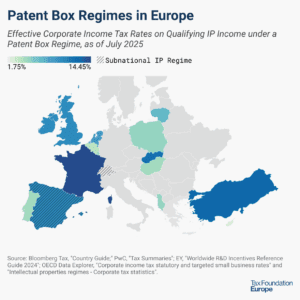
The EU Budget’s CORE Is Rotten
5 min readBy:Key Points
- The European Commission is proposing new sources of revenue for its budget.
- The “Corporate Resource for Europe,” or CORE, focuses on businesses with at least €100 million in net turnover and requires annual lump sum contributions.
- Policymakers should avoid funding the EU budget with policies that do not align with ability to pay or are poorly designed. Instead, broader revenue sources like the value-added tax own resource should be prioritized.
This week, the European Commission proposed new budget options for its next multiannual financial framework (MFF), which will run from 2028 to 2034. While it covers all aspects of the EU budget, it is worth zooming in on one new proposal for revenues that would support EU-level spending. The “Corporate Resource for Europe,” or CORE, provides a good opportunity to think through how best to raise revenue for the EU budget.
The MFF commonly includes proposals for new own resources, the policies that fund the EU budget. The Commission’s full proposal to the Council details the various options on the table. Among these are unsurprising adjustments to environmental measures like the Energy Trading System (ETS) and the Carbon Border Adjustment Mechanism (CBAM). There are also new proposals for a taxA tax is a mandatory payment or charge collected by local, state, and national governments from individuals or businesses to cover the costs of general government services, goods, and activities. on electronic waste and a tobacco excise duty.
However, the focus of this blog post will be on a new and strange approach to business taxation: the CORE. The EU’s acronym creativity is going a bit far, and so is this proposal.
The EU itself has very little tax authority; much of that is left to national capitals, so when the Commission proposes new sources of funding for its budget, it must be careful to tailor those proposals so that they do not appear to encroach on national sovereignty.
The CORE is a great example of these trade-offs and the creativity of policymakers in Brussels. Unfortunately, it is also a bad example of policy design.
The CORE, while still a tax, looks a bit strange. It is a lump sum required from companies that is based on a company’s net turnover.
Net turnover is the revenue a company earns from sales with adjustments for rebates, value-added tax (VAT), and other taxes on turnover. It is not a measure of profit or net income, which are standard starting points for taxes on businesses.
Businesses with less than €100 million in net turnover are excluded from the CORE. Above that threshold, though, a bracketed approach is used to determine a company’s annual lump sum payment with amounts ranging from €100,000 to €750,000.
Calculating the CORE
| Annual net turnover of a company | Annual CORE Contribution |
|---|---|
| Less than €100 million | Exempt |
| Above €100 million and below €250 million | € 100,000 |
| Above €250 million and below €500 million | € 250,000 |
| Above €500 million and below €750 million | € 500,000 |
| Above €750 million | € 750,000 |
While the bracketed approach is simple and straightforward, it ignores some important realities.
First, it does not respect a company’s ability to make the payment. Even a company with €750 million in annual net turnover can run a loss in a given year. This proposal would require businesses that are making zero net income, or even losing money, to pay into the EU budget.
Second, the design creates notches in the tax burden. A company that has €100 million in annual net turnover is expected to pay 0.1 percent. However, a company with €249 million in annual net turnover would pay 0.04 percent. Notches like these create planning opportunities for businesses.
Also, a company with €2 billion in annual net turnover would pay 0.04 percent as well. Because the highest amount is capped at €750,000, the businesses with the highest amounts of turnover would pay the lowest effective rate relative to net turnover.
The Commission has designed a tax that is more aggressive at specific points but then becomes less meaningful as net turnover rises.
Taxes on turnover are bad policy to begin with, but the CORE’s lump sum feature introduces particularly strange outcomes. The solution, however, is not to apply a 0.1 percent rate to net turnover. If the Commission wants to tax businesses directly (and the Council agrees), then it should use a net profits tax.
Third, none of the amounts or thresholds are inflationInflation is when the general price of goods and services increases across the economy, reducing the purchasing power of a currency and the value of certain assets. The same paycheck covers less goods, services, and bills. It is sometimes referred to as a “hidden tax,” as it leaves taxpayers less well-off due to higher costs and “bracket creep,” while increasing the government’s spending power. -adjusted. This means that, over time, companies could find themselves in higher brackets simply because the price level continues to rise. Also, it means the contribution amounts will be less significant over time.
Fourth, the logic behind this proposal is questionable. The Commission’s proposal suggests that companies operating in the EU benefit from public goods provided by the EU. This benefit principle is common in tax policy discussions, but, historically, the EU has focused on the benefits it provides to its Member States and individual EU citizens rather than corporate entities. If there is a benefit provided to corporations, then the first point about ability to pay comes back into play. Shouldn’t the obligation to pay into EU funds be targeted at businesses that are benefiting the most from the public goods? A profits tax would make more sense, but that would also trigger a strong reaction from EU Member States on the grounds that the EU is overstepping the boundaries of its role in taxation.
An expanded EU budget surely demands more sources of funding. However, the CORE is clearly flawed. The Commission could have followed the same approach that it has taken with the ETS and the CBAM and recommended a larger own resource based on the VAT. A broader VAT own resource could be tailored to the amount of desired revenue, and it could also be justified by the role that the EU has played in supporting the expansion of the VAT base in recent years, particularly for digitally provided services.
In this latest budget, the VAT own resource is a flat 0.3 percent of total VAT revenues as a fraction of the weighted average VAT revenues. This approach includes a pivot away from a prior cap that complicated and limited the VAT own resource. The share of own resources supported by VAT was only 9 percent in 2023, down from 60 percent in 1988. Policymakers could re-examine the revenue needs that the CORE is supposed to fill and adjust the VAT own resource further, but the CORE itself may not have a future.
According to Politico, policymakers in Germany have already spoken out against the budget proposal, so it seems unlikely that the CORE will make it into EU law. Still, as discussions continue in Brussels, the CORE’s mistakes provide a lesson on what to avoid.
Share this article




